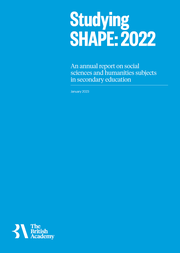Summary
'Studying SHAPE: 2022' is the first in an annual series of reports providing a snapshot of the number of students undertaking the most common secondary and further education qualifications in the UK, in humanities and social science subjects. This work expands upon the initial commentary already provided by the Academy following A level and GCSE results and, alongside other resources available through the British Academy’s SHAPE Observatory, supports the Academy’s role in providing objective data on the health of SHAPE disciplines.
For the purposes of this pilot report, our analysis focuses on those SHAPE subjects in the social sciences and humanities which are aligned with the subject Sections into which the Fellowship of the British Academy is organised. In this first year, we are piloting our approach across this report and accompanying resources, and plan to build on the methods and nature of the analysis across subjects for future years.
This report considers data on A level and GCSE entries in England, Wales and Northern Ireland, as well as at National 5, Higher, and Advanced Highers in Scotland, analysing trends in student numbers over a ten-year period (or six-year period in the case of Scottish qualifications, following the introduction of new and updated qualifications between 2013 and 2016). It looks at changes to absolute numbers as well as relative shifts in the popularity of subjects.
To support this analysis, the Academy has also launched SHAPE Indicators, a data visualisation resource which brings together vital statistics on the health of the humanities and social sciences, offering additional subject-level visual analysis, which can be used alongside the analysis and figures presented in this report. Together, these resources provide government, policymakers, journalists, the UK’s disciplinary communities, the public and those working in the higher education sector with an accessible evidence base for the subjects.
Summary of findings
GCSE trends across the social sciences and humanities
Looking at the social sciences and humanities respectively as subject groupings, we find that both have shown positive trends at GCSE level in the decade since 2012.
There has been above average growth in social science GCSE entries, compared to entries across all GCSE subjects, since 2012, and above average growth in GCSE humanities entries since 2016. The share of social sciences and humanities GCSE entries likely reflect curriculum requirements and individual school policies at this level of education in England, Northern Ireland and Wales.
Humanities GCSE entries were subject to falls in numbers between 2013 and 2016, before recovering thereafter. GCSEs in social science subjects have shown consistent growth over a ten-year period, but were starting from much smaller overall numbers and still only make up a relatively small percentage of all GCSEs.
A level trends across the social sciences and humanities
For A levels, percentage changes were similar for social sciences and humanities up until 2015, after which point, they have been subject to contrasting trajectories.
Entries to social science A levels have risen considerably despite the 18-year-old population declining for most of the period.
Humanities A level entries, on the other hand, have seen quite consistent decreases since 2015, at a rate that is disproportionate to wider demographic shifts.
Trends in Scotland
It is harder to identify any clear trends in Scotland since 2016, due in part to the fact that the dataset here is smaller. Both social science subjects and humanities respectively have been subject to minor fluctuations since 2016. The only exception to this appears to be a more marked growth in social science National 5 entries between 2020 and 2022.
Both social sciences and humanities have seen decreases in the number of entries for Highers. Entries for Advanced Highers saw some minor decreases between 2016 and 2019 for each subject grouping, although this was largely in line with percentage changes in the Scottish 18-year-old population. Since 2019, both subject groups have exceeded their 2016 total for entries, with an increase for social sciences.
Trends at social science subject level
Looking at numbers at subject level, most social science subjects have seen entry numbers grow over the past decade at both GCSE and A level. Subjects such as Geography, Sociology, and Psychology remain amongst the most popular subjects at both GCSE and A level.
In Scotland, since the introduction of National 5, new Higher, and new Advanced Higher qualifications, some social science subjects such as Economics and Politics have also seen an increase in entries. However, for other social science subjects, such as Geography, Accounting, and Business Management, the overall picture is more mixed. Most social science subjects at the National 5, Higher and Advanced Higher levels saw an increase in entries between 2021 and 2022, with the exception of Accounting, which saw numbers decrease in this period across all Scottish qualification levels.
Trends at humanities subject level
The picture for humanities subjects for secondary education has been more mixed over the past decade; a trend that has continued in 2022. English, History and Religious Studies remain the most popular humanities subjects at GCSE, though with differing outlooks over the past decade; at A level, the most popular humanities subjects are History and English Literature. The picture for the vast majority of languages in particular, has been one of decline at all levels of provision. Between 2021 and 2022, numbers across almost all humanities subjects either decreased or saw only a slight increase.
In Scotland, there have been increases for some humanities subjects across all qualification levels since 2016, particularly Chinese. The picture for other, larger subjects has been more mixed, with declines in numbers for History, Philosophy and particularly in French and German since 2016.
